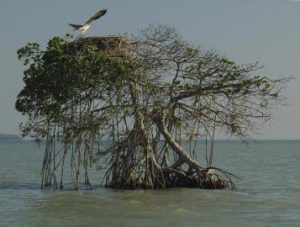Mangrove is the collective name given to unrelated plants around the world that have filled a niche because they can tolerate salt or brackish water. Mangroves don’t require saltwater to grow. However, they have specialized mechanisms that allow them to exclude or filter out salt. True mangroves also have other specialized adaptations that allow them to thrive in coastal tidal areas. Mangroves have roots that can serve both as anchors in soft sediment and allowing gas exchange. These trees have unique floating propagules, formed from seeds that germinate while still attached to the tree. This allows for distant dispersal utilizing tides and currents. Because of these adaptations there is little competition from other non-mangrove plant species. Almost all mangroves are found in tropical and subtropical regions of the world.
Why are mangroves important?
Mangroves are important for a number of reasons. Their complex stilt or peg-like root structures not only provide anchoring for plants, but also help prevent erosion and stabilize the coastline. Mangrove ecosystems are limited in plant diversity because few plants are well-adapted to handle the harsh growing conditions. This does not mean that they lack diversity in other types of organisms. Mangroves provide a home to countless marine species including crustaceans and juvenile fish. This makes mangrove systems important to commercial and sport fisheries. Mangroves also provide important habitat for birds, mammals and reptiles. In Florida, these include nine endangered and three threatened species.

What mangroves are found in Florida?
Here in Florida, there are three native mangrove species that occur throughout most of the state. These are the Black Mangrove (Avicennia germinans), White Mangrove (Laguncularia racemosa), and Red Mangrove (Rhizophora mangle). In Flagler County the Black Mangrove is the dominant species. Although they are known to grow in the River to Sea Preserve, there are currently no vouchered records of white or red mangroves in Flagler county. Historically, these species have been less common than Black Mangroves due to their cold-sensitivity.
In South Florida, there are two non-native species of mangroves that have escaped cultivation. The first, Large Leaf Mangrove (Bruguiera gymnorhiza) was originally collected in Indonesia by the renowned explorer and plant collector David Fairchild. They were planted around 1940 at his estate in Coral Gables, Florida. The second, commonly known as Asian Black Mangrove (Lumnitzera racemosa) was planted in 1970 by horticulturists with the Fairchild Tropical Botanic Garden, which is also located in Coral Gables (and was named after Mr. Fairchild).
For more information you can check out these EDIS documents: Mangroves, Avcennia germinans, Black Mangrove and this article from the Miami Herald.
How humans have impacted mangroves
Florida settlers used mangroves to tan hides, as cooking fuel, and for fence posts. This use reduced the size of mangrove forests over time. Important natural mangrove habitats are in decline worldwide due to human activities. These include conversion for urban land development, use for agricultural production, timber, and other purposes. In addition to removal for human uses, Florida’s mangroves face competition from a salt-tolerant invasive plant known as the Brazilian pepper-tree. Brazilian pepper-trees thrive in coastal habitats. This allows them to compete with mangroves for resources. Well-established, healthy mangrove communities have been replaced over time by communities dominated by this single invasive species. This has had a negative effect on the diversity of life once found there. There are increasing Brazilian pepper-tree removal efforts in northeast Florida.
Florida has regulations that protect mangroves from removal and pruning. The 1996 Mangrove Trimming and Preservation Act prohibits trimming or alteration of mangroves on publicly-owned lands. A permit may need to be obtained to remove any part of a mangrove tree on private property. To be certain no regulations are violated contact a certified mangrove trimmer or contact the Florida Department of Environmental Protection.
Sol Looker is the Residential Horticulture Extension Agent and Master Gardener Coordinator at the UF/IFAS Extension Flagler County Office.
 2
2
